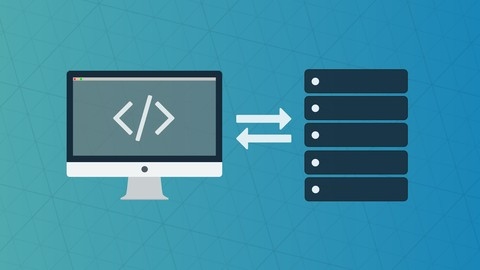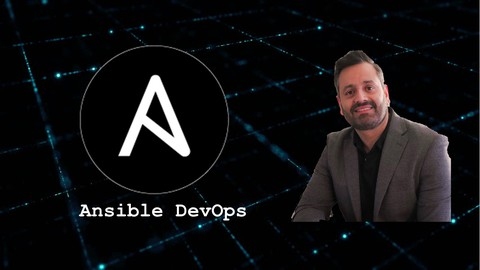Ansible for the Absolute Beginner - Hands-On - DevOps
This course covers Ansible, a popular open-source tool used for automating software provisioning, configuration management, and application deployment.
It starts with an introduction to Ansible and its configuration files, where you’ll learn about YAML, a human-readable data serialization format.
You’ll then dive into Ansible inventory, which is how you define the hosts or systems you want to manage with Ansible.
The course covers different inventory formats, grouping, and parent-child relationships.
Next, you’ll explore Ansible variables, including variable types, registering variables, variable precedence, scoping, magic variables, and Ansible facts.
This is a crucial aspect of Ansible, as variables allow you to customize your playbooks and make them more dynamic.
Speaking of playbooks, the course dedicates a chapter to understanding and developing Ansible playbooks, which are the scripts that define the tasks you want to automate.
You’ll learn how to verify playbooks, use Ansible-lint for linting, and work with conditionals and loops.
The course also covers Ansible modules, which are the building blocks of Ansible playbooks.
You’ll learn about different modules, how to read Ansible documentation, and how to use various modules in your playbooks.
Additionally, the course covers best practices such as handlers, roles, and collections, which help you organize and manage your Ansible code more effectively.
In the advanced topics section, you’ll learn about Windows support, patterns, Ansible-Galaxy (a hub for finding and sharing Ansible roles), dynamic inventory, and custom modules.
The course also touches on templating with Jinja2, which allows you to create dynamic configurations.
The course includes coding exercises and labs to reinforce your learning, and you’ll have access to a community channel for support and interaction.
There are also demos on setting up a lab environment with VirtualBox and installing Ansible.
Mastering Ansible
You’ll start by setting up your environment, including access to a control machine and servers running Ubuntu 14.04.
The course guides you through installing Ansible and understanding its foundational concepts like inventory files, host selection, tasks, and plays.
You’ll dive into writing playbooks, which are Ansible’s way of automating IT processes.
The course covers package management with apt, handling services like Apache, copying files, using templates, and managing databases and users with modules like mysql_db and mysql_user.
Along the way, you’ll learn techniques like looping with with_items, using handlers for service restarts, and enabling privilege escalation with become.
The course then explores modular configuration using roles, a way to organize and share Ansible code.
You’ll learn how to work with variables from various sources like defaults, vars files, and group_vars.
The course even covers encrypting sensitive data with Ansible Vault.
Advanced execution topics are covered, such as limiting execution to specific hosts or tasks, checking for idempotence, and using accelerated mode for faster execution.
You’ll also learn troubleshooting techniques like debugging with the debug module, retrying failed hosts, and syntax checking.
Finally, the course provides an overview of setting up a development environment with Docker, as well as brief introductions to YAML and Jinja2, which are essential for working with Ansible.
Ansible Advanced - Hands-On - DevOps
The course starts with an introduction and a recap to ensure you have the necessary prerequisites.
You’ll then learn how to set up your environment, including a demo and extras for using Docker.
The course provides coding exercises and a community channel for support.
Next, you’ll dive into web application deployment.
You’ll learn how to install a web application on CentOS 7 and develop a playbook for a simple web app.
The course covers various aspects of web app deployment through multiple lectures.
File separation is another key topic, with a demo and several lectures breaking it down step-by-step.
Roles are introduced, with a demo and multiple lectures covering different aspects of roles in Ansible.
The course then moves on to asynchronous actions, exploring different scenarios through several dedicated lectures.
You’ll also learn about strategies in Ansible, with lectures covering various strategy types and use cases.
Error handling is an important part of any automation tool, and this course dedicates two lectures to this topic.
Templating with Jinja2 is covered in-depth, with six lectures walking you through different templating concepts and examples.
Lookups and Vault are other essential Ansible features that are explored in the course.
You’ll learn about dynamic inventory, custom modules, and plugins as well.
The course wraps up with a conclusion and a bonus lecture on other courses offered by the instructor.
Dive Into Ansible - Beginner to Expert in Ansible - DevOps
The course starts by providing an overview and introduction to Ansible, explaining its motivations, learning outcomes, and structure.
You’ll set up a lab environment, install Docker, configure SSH connectivity between hosts, and set up the course repository.
After the initial setup, you’ll dive into Ansible’s architecture and design, learning about its configuration, inventories, and modules.
The course covers Ansible playbooks in-depth, including their structure, variables, facts, and templating with Jinja2.
You’ll learn how to create and execute playbooks, as well as advanced topics like dynamic inventories, registers, conditionals, looping, asynchronous execution, task delegation, magic variables, and blocks.
Security is also covered, with a section on Ansible Vault for encrypting sensitive data.
The course teaches you how to structure playbooks using includes, imports, tags, and roles, making your code more modular and maintainable.
You’ll learn how to use Ansible with cloud services like AWS and containers like Docker.
The course even covers creating your own Ansible modules and plugins.
Other topics include troubleshooting Ansible, best practices, and supplementary resources.
Throughout the course, you’ll work with key technologies like YAML and Jinja2 templating.
Ansible for Network Engineers: Quick Start GNS3 & Ansible
The course starts by guiding you through installing GNS3, a network simulation software, and setting up Cisco IOS images within it.
This hands-on approach ensures you have a practical environment to work with Ansible.
Once the setup is complete, you’ll dive into Ansible itself.
You’ll learn how to use ad-hoc commands to perform basic tasks across multiple devices.
Then, you’ll move on to writing raw playbooks to automate more complex operations like retrieving ARP cache, MAC address tables, and saving configuration outputs to files.
The course covers using the Cisco IOS command and config modules within Ansible playbooks.
You’ll write playbooks to configure interfaces, routing protocols, and other settings across your simulated Cisco devices.
This practical experience is invaluable for understanding how Ansible can simplify network management.
Beyond Cisco IOS, the course explores automating Cumulus Linux networks with Ansible.
You’ll learn about DevOps methodologies, Zero Touch Provisioning (ZTP), and scaling Ansible with roles and includes.
Real-world demos reinforce these concepts.
Throughout the course, you’ll work with Ansible’s configuration files, modules, ad-hoc commands, and multi-tier playbooks.
The hands-on projects ensure you gain experience writing playbooks of increasing complexity for network devices.
By the end, you’ll understand how to leverage Ansible for comprehensive network automation across various platforms like Cisco and Cumulus.
Complete DevOps Ansible Automation Training
You’ll start by learning what Ansible is, its history, benefits, and how it works compared to other automation tools.
Once you have the basics down, you’ll dive into setting up a lab environment with virtual machines and installing Ansible.
This hands-on approach will help you grasp concepts better.
The course then moves on to writing simple playbooks using YAML syntax.
You’ll learn how to create playbooks for tasks like installing services, copying files, and managing user accounts on remote clients.
But it doesn’t stop at just playbooks.
You’ll also explore ad-hoc commands, which are great for quick tasks without writing full playbooks.
As you progress, you’ll unlock more advanced Ansible features like roles for better organization, tags for running specific parts of playbooks, variables for dynamic configuration, and constructs like handlers, conditions, and loops.
Securing your Ansible setup is crucial, so you’ll learn how to use the Ansible Vault to encrypt sensitive data.
The course even touches on Ansible management tools like AWX and Tower.
Throughout the course, you’ll have access to handouts and quizzes to reinforce your learning.
Ansible for the DevOps Beginners & System Admins
You’ll start by understanding what Ansible is and how it works, setting up an Ansible lab environment on AWS EC2 instances running RHEL (Red Hat Enterprise Linux) as managed nodes.
From there, you’ll dive into the core components of Ansible, including ad-hoc commands, inventory management, configuration files, and modules.
You’ll learn how to create and run your first Ansible playbook, a set of instructions for automating tasks across multiple systems.
The course covers essential Ansible modules like Yum for package management, File for creating and removing files/directories, and Copy for transferring files to managed nodes.
You’ll also learn how to write multi-task playbooks, handle notifications and handlers, and use conditional statements to control execution flow.
As you progress, you’ll tackle more advanced topics like working with lists and loops (with_items), defining and using variables, and implementing error handling in your playbooks.
The course even covers Ansible Vault for encrypting sensitive data and integrating Ansible with Git for version control.
One of the highlights is learning about Ansible Roles, a way to organize and share Ansible code for reusability.
You’ll convert an existing playbook into a role and push your Ansible code to GitHub.
Throughout the course, you’ll work on practical labs, such as installing Apache on RHEL and Ubuntu systems using Ansible playbooks.
This hands-on approach ensures you gain real-world experience with Ansible automation.
Automation with Ansible Playbooks - Hands On !!
This course covers Ansible from the basics to advanced topics like roles and custom automation tools.
You’ll start by learning what Ansible is, its architecture, and how to set it up.
The course covers Ansible’s control node components, inventories, and how to customize its behavior.
You’ll dive into ad-hoc commands and playbooks, which are essential for automating tasks.
The course covers modules, which are the building blocks of Ansible, and how to use them effectively.
You’ll learn about variables, conditionals, loops, and handlers, which allow you to create more complex and dynamic playbooks.
The course also covers roles, which are a way to organize and reuse Ansible code.
You’ll learn how to create and use roles, which can save you a lot of time and effort.
The course includes two industrial projects: one on patching Linux servers and another on stopping and starting Control M applications.
These projects will give you hands-on experience with real-world scenarios.
The course also covers how to create an automation tool using Ansible and shell scripting.
You’ll learn how to design the tool’s front-end, implement user administration tasks, and monitor system health using Ansible playbooks and shell scripts.
Throughout the course, you’ll have plenty of opportunities to practice what you’ve learned through lab sessions and exercises.
You’ll learn how to install Ansible, work with ad-hoc commands, create playbooks, manage variables, and more.
Ansible Tower Overview
The course provides a comprehensive introduction to Ansible Tower, a powerful platform for automating IT operations.
You’ll start with an overview of Ansible and Ansible Tower, exploring its key features that streamline configuration management, application deployment, and task automation across your infrastructure.
Next, you’ll dive into setting up Ansible Tower, including the installation process and navigating the web interface.
The course covers essential concepts like role-based access control (RBAC) and organizational roles, allowing you to manage user permissions and delegate responsibilities effectively.
Through hands-on lab sessions, you’ll gain practical experience creating and managing Ansible Tower users, teams, inventories, and credentials.
This includes working with static inventories and configuring dynamic inventories for AWS EC2 environments, enabling seamless integration with cloud resources.
The course also introduces you to Git and GitHub, teaching you how to install and configure Git, push files to GitHub repositories, and manage Ansible projects using version control.
This skill is crucial for collaborating on Ansible playbooks and roles with your team.
Throughout the course, you’ll have the opportunity to reinforce your learning with multiple practice lab sessions.
These sessions cover tasks like running jobs to update file content, restarting services, delegating permissions, and more, ensuring you gain hands-on experience with Ansible Tower’s powerful automation capabilities.
Ultimate Ansible Bootcamp by School of Devops®
You’ll start by understanding what Ansible is, its key features like simplicity, YAML-based syntax, push model, and infrastructure-as-code approach.
The instructor, Gourav Shah, will guide you through setting up the environment, including using codespaces on DigitalOcean.
A significant portion focuses on the core Ansible components - ad-hoc commands, modules for desired state management, playbooks for multi-machine deployments, and roles for better code organization.
You’ll learn YAML syntax, write your first playbook, and troubleshoot failures.
The course emphasizes best practices like separating code from data using variables and templates with Jinja2.
It covers advanced topics like Ansible Galaxy for reusable roles, control structures like conditionals and loops, facts for system discovery, and Ansible Vault for encrypting sensitive data.
You’ll apply these concepts to use cases like deploying a DevOps demo app, managing multiple environments, and rolling updates.
The hands-on labs reinforce concepts like configuring Apache, PHP, HAProxy load balancer, and MySQL database.
You’ll automate tasks like user management, package installation, and config file management across Linux distributions.
The “Ansible Playbook Essentials” book recommendation provides supplemental learning.










